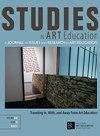{"title":"A P(art)ial Education","authors":"R. Sweeny","doi":"10.1080/00393541.2021.2021040","DOIUrl":null,"url":null,"abstract":"A s I begin my 2-year term as senior editor of Studies in Art Education, I would like to thank the many individuals who have been supportive to me during my tenure as associate editor. First, I would like to thank Dónal O’Donoghue, past senior editor, for his guidance and vision. It has been a pleasure to work with Dónal over the past 2 years, and the model that he has put forth for what Studies can be is forwardthinking and much appreciated. Next, I want to thank Kryssi Staikidis for her tireless work as associate editor. I cannot think of anyone I would rather work with in this position. Kryssi brings a wealth of knowledge about a diverse range of approaches to art education research, which surely benefits the journal in a variety of ways. I would also like to thank Laura Trafí-Prats for her excellent work as commentary editor, and Ryan Shin for his dedication to the journal as media review editor. Both are a pleasure with which to work, and their contributions to the dynamic and socially engaged potential of Studies are worthy of note. In addition, I am looking forward to working with Janice Hughes, publications manager at National Art Education Association (NAEA), and Katherine Holland, editorial assistant at NAEA. Last, I want to thank the editorial review board for their consistent quality and quantity of author reviews. These are truly what guide the direction of the journal, and often this work is done behind the scenes and in the background. Only the senior editor sees the amount of thought and action “It is from these partial views that we can understand the general parameters of the field of art education, which is temporal, dynamic, embodied, and socially engaged.” © 2022 National Art Education Association Studies in Art Education: A Journal of Issues and Research 2022, 63(1), 3–8 DOI: 10.1080/00393541.2021.2021040","PeriodicalId":45648,"journal":{"name":"Studies in Art Education","volume":"12 1","pages":"3 - 8"},"PeriodicalIF":0.6000,"publicationDate":"2022-01-02","publicationTypes":"Journal Article","fieldsOfStudy":null,"isOpenAccess":false,"openAccessPdf":"","citationCount":"0","resultStr":null,"platform":"Semanticscholar","paperid":null,"PeriodicalName":"Studies in Art Education","FirstCategoryId":"1085","ListUrlMain":"https://doi.org/10.1080/00393541.2021.2021040","RegionNum":0,"RegionCategory":null,"ArticlePicture":[],"TitleCN":null,"AbstractTextCN":null,"PMCID":null,"EPubDate":"","PubModel":"","JCR":"Q3","JCRName":"EDUCATION & EDUCATIONAL RESEARCH","Score":null,"Total":0}
引用次数: 0
艺术教育
在我开始担任《艺术教育研究》高级编辑的两年任期之际,我要感谢在我担任副编辑期间一直支持我的许多人。首先,我要感谢Dónal前高级编辑O 'Donoghue的指导和远见。在过去的两年里,我很高兴与Dónal合作,他提出的研究模式是前瞻性的,非常值得赞赏。接下来,我要感谢Kryssi Staikidis作为副主编孜孜不倦的工作。在这个职位上,我想不出还有谁比我更愿意共事。Kryssi带来了丰富的关于艺术教育研究的各种方法的知识,这肯定会在各个方面使期刊受益。我还要感谢Laura Trafí-Prats作为评论编辑的出色工作,以及Ryan Shin作为媒体评论编辑为杂志做出的贡献。两者都是一种愉快的工作,它们对研究的动态和社会参与潜力的贡献值得注意。此外,我期待着与全国艺术教育协会(NAEA)的出版物经理珍妮丝·休斯和NAEA的编辑助理凯瑟琳·霍兰德合作。最后,我要感谢编辑评审委员会对作者评审的一贯质量和数量。这些才是真正指导期刊方向的东西,而且这些工作通常是在幕后和背景中完成的。正是从这些局部的观点中,我们可以了解艺术教育领域的总体参数,即时代性、动态性、具体化和社会性。©2022全国艺术教育协会艺术教育研究:问题与研究学报,2022,63(1),3-8 DOI: 10.1080/00393541.2021.2021040
本文章由计算机程序翻译,如有差异,请以英文原文为准。


